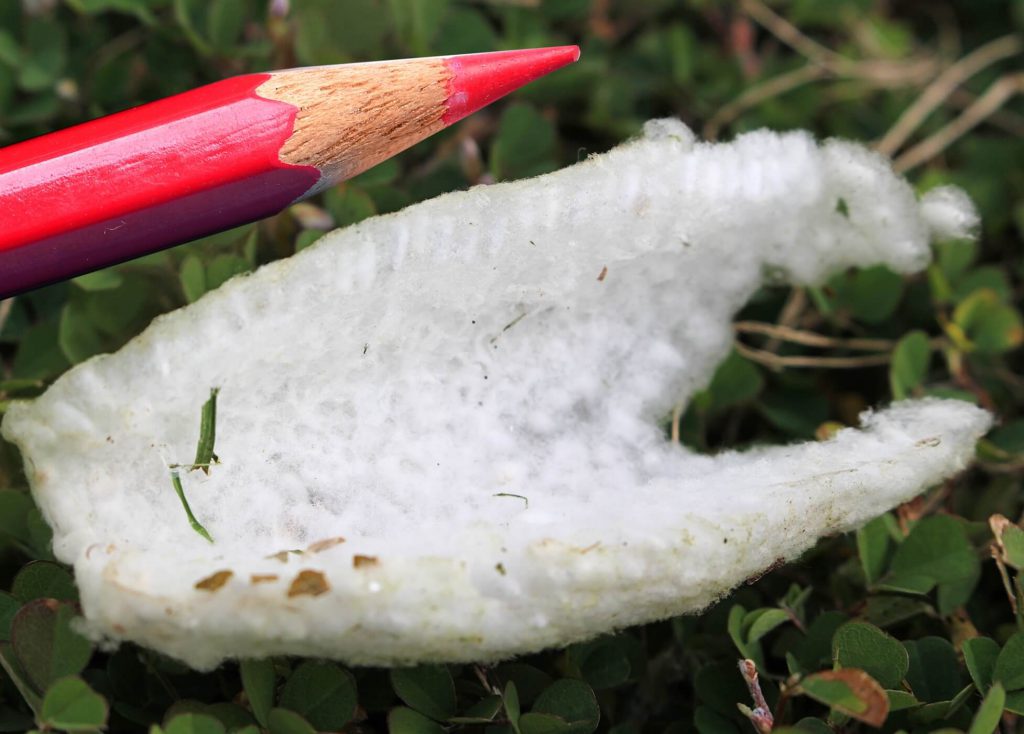 For every pest, there always seems to be a pest of that pest – a predator, parasite or some type of beneficial organism – that suppresses any aforementioned pest to levels we can live with. One example is the papaya hornworm. The caterpillar of a sphinx moth, the papaya hornworm is a pest of papaya. This caterpillar feeds on the leaves and almost hides in plain sight as it devours the foliage. However, there is a small parasitic wasp that can take down these mighty munchers. What is the rest of the story on this natural parasite/prey relationship?
For every pest, there always seems to be a pest of that pest – a predator, parasite or some type of beneficial organism – that suppresses any aforementioned pest to levels we can live with. One example is the papaya hornworm. The caterpillar of a sphinx moth, the papaya hornworm is a pest of papaya. This caterpillar feeds on the leaves and almost hides in plain sight as it devours the foliage. However, there is a small parasitic wasp that can take down these mighty munchers. What is the rest of the story on this natural parasite/prey relationship?
The papaya hornworm or Erinnyis alope, is the caterpillar of a somewhat nondescript sphinx moth of the normal classic streamlined shape. The caterpillar tends to be green (but it can also be brown) with the telltale horn-like projection at the tail-end. The front part of the caterpillar sports an eye-like spot near its head which may alarm predators in a pinch. Now while we are calling it the papaya hornworm, it can also eat poinsettia, cassava, jatropha, and even allamanda. While I have seen this caterpillar feeding on poinsettia, I see them mostly on papaya. A green morph of this caterpillar has the ideal color and markings to blend into a leaf as it almost looks like a vein in the foliage. You might see some chewed areas on a leaf, and even see some large droppings below, but you just cannot see it at a glance. Take some time to scan the leaves and let your eyes adjust and finally you should be able to detect these fairly large caterpillars and hand-pick them as needed. Overall, while the damage is noticeable, the overall impact to the papaya tree is minimal.
So, you missed finding the papaya hornworm eating your papaya leaves. Other eyes are on duty as they search for a host to feed a large brood. Enter a type of braconid wasp – a parasitoid. This tiny insect seeks out a host caterpillar on a papaya tree and carefully lays eggs into its host. The eggs hatch and the wasp grubs feed on the living caterpillar. When mature, the wasp larvae chew their way out of their host and then pupate in mass on the surface of the dead and/or dying caterpillar. This mass of pupa are imbedded in a white cottony, silk-like, fluffy material that they prepare for their resting stage. Think of it as a “caterpillar hotdog” in a “braconid wasp bun”. The caterpillar dies leaving the curved blanket of braconid wasp aggregated pupal mass. This cottony mass may stay on the leaf or detach and drop to the ground. When mature, hundreds of tiny wasps emerge from their individual pupae and begin to look for new hosts.
While some natural controls may be gruesome when carefully examined, the particular fate of the papaya hornworm is fairly neat and tidy – cottony even! For more information on all types of natural controls, please call our Master Gardener volunteers on the Plant Lifeline on Mondays, Wednesdays and Fridays from 1 to 4 pm at 764-4340 for gardening help and insight into their role as an Extension volunteer. Just as a reminder, we have moved to our new office at the North Charlotte Regional Park at 1120 O’Donnell Blvd, Port Charlotte FL 33953.. Our phone numbers and email addresses will remain the same. Don’t forget to visit our other County Plant Clinics in the area. Please check this link for a complete list of site locations, dates and times – https://sfyl.ifas.ufl.edu/media/sfylifasufledu/charlotte/docs/pdf/Plant-Clinics-Schedule1.pdf. Our Eastport Environmental Demonstration Garden is always open to the public outside the gate at 25550 Harbor View Road. Master Gardener volunteers tend this garden on Tuesday mornings from 8 to 10 am and are available for questions. Ralph E. Mitchell is the Director/Horticulture Agent for the UF/IFAS Charlotte County Extension Service. He can be reached at 941-764-4344 or ralph.mitchell@charlottecountyfl.gov.
Resources:
Alope sphinx moth – Erinnyis alope – http://www.floridanaturepictures.com/butterflies/butter34.htm
Kesting-Handly, T. & Kloiber S. (2018) Parasitoids and Predators. https://www.sphingidae.us/parasitoids-and-predators.html
Oehlke, B. (2019) Erinnyis alope http://www.silkmoths.bizland.com/Sphinx/ealope.htm
Harty K. (2015) Papaya Hornworm https://growagardener.blogspot.com/2015/11/papaya-hornworm.html
Morton, J. 1987. Papaya. p. 336–346. In: Fruits of warm climates. Julia F. Morton, Miami, FL.
What’s That Worm? (2012) UF/IFAS Extension – Pinellas County https://blogs.ifas.ufl.edu/pinellasco/2012/06/20/whats-that-worm/
 1
1

Comments are closed.